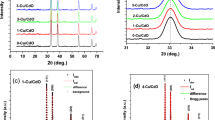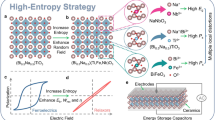Abstract
The electrooptic properties of hot-pressed lead zirconate titanate ceramics and their applications are reviewed. Coarse-grained, bismuth-doped ceramics with average grain size greater than 2 ώm have light scattering properties that can be varied by switching the orientation of the ferroelectric polarization. Fine-grained bismuth-or lanthanum-doped ceramics have an effective birefringence that can be varied either by applying an external electric field (conventional electrooptic effect) or by partially switching the remanent polarization (electrooptic memory effect). Ba, Sn, or La modifications of the lead zirconate titanate system produce materials with improved switching characteristics and electrooptic effects similar to those of fine-grained bismuth-or lanthanum-doped ceramics. Lanthanum modified lead zirconate titanate (PLZT) is significantly more transparent than other electrooptic ceramics. The PLZT system includes materials with electrooptic memory and either linear or quadratic electrooptic effects. The electrooptic properties of modified lead zirconate titanate ceramics, especially PLZT, combined with localized switching and modulation capabilities are particularly suitable for information storage and display devices.
Similar content being viewed by others
References
G. H. Haertling:Am. Ceram. Soc. Bull., 1964, vol. 43, pp. 875–79.
G. H. Haertling and W. J. Zimmer:Am. Ceram. Soc. Bull., 1966, vol. 45, pp. 1084–89.
G. H. Haertling:Am. Ceram. Soc. Bull., 1970, vol. 49, pp. 564–67.
C. E. Land and P. D. Thacher:Proc. IEEE, 1969, vol. 57, pp. 751–68.
P. D. Thacher and C. E. Land:IEEE Trans. on Electron Devices, 1969, vol. ED-16, pp. 515–21.
C. E. Land and R. Holland:IEEE Spectrum, 1970, vol. 7, pp. 71–78.
C. E. Land and G. H. Haertling:Proc. 2nd Intl. Mtg. on Ferroelectricity, Kyoto, Japan, Suppl. to J. Phys. Soc. Japan, 1970, vol. 28, pp. 96–99.
C. E. Land:Intl. J. Nondestructive Testing, 1970, vol. 1, pp. 315–36.
G. H. Haertling and C. E. Land:J. Am. Ceram. Soc., 1971, in press.
J. R. Maldonado and A. H. Meitzler:IEEE Trans. on Electron Devices, 1970, vol. ED-17,pp. 148–57.
A. H. Meitzler, J. R. Maldonado, and D. B. Fraser:Bell System Tech. J., 1970, vol. 49, pp. 953–67.
J. R. Maldonado and A. H’ Meitzler: “Strain-biased ferroelectric picture devices,” presented at the IEEE Electron Device Research Conference, Seattle, Wash., June 1970; also to be sumitted to Proc. IEEE.
P. D. Thacher:J. Appl. Phys., 1970, vol. 41, pp. 4790–97.
Author information
Authors and Affiliations
Additional information
This manuscript is based on an invited paper presented at the annual conference sponsored by the Electronic Materials Committee of the Institute of Metals Division of the Metallurgical Society of AIME and held August 30–September 2, 1970, in New York City.
Rights and permissions
About this article
Cite this article
Land, C.E. Ferroelectric ceramics for information storage and display. Metall Trans 2, 781–788 (1971). https://doi.org/10.1007/BF02662736
Issue Date:
DOI: https://doi.org/10.1007/BF02662736




